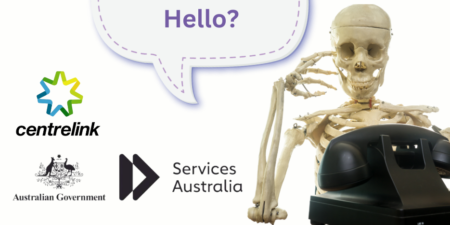If you've tried to call Centrelink in the last year, this will come as no surpriseLAST week Services Australia released their 2022-23 Annual Report. This comes after media attention around a significant blowout to wait times, with only 23% of calls to Centrelink making it through to a service representative in July and August this year.
That means less than 1 in 4 calls were answered.
Medicare and Centrelink both come under the Services Australia banner, as well as several other important social programs.
Many services can be accessed online through MyGov, but for some that isn’t an option. Not all of us live close to a service center or have the means to travel. Many have a hard time using online services, or have accessibility needs that mean telephone contact is a necessity.
As always, it’s the people who most need Government services that have the hardest time accessing them.
Services Australia’s annual report is creative in its performance measures – there is a self-identified target of serving 70% of customers within 15 minutes. Overall, only 60% of customers received support in this time, and only 36% of callers who were seeking information on social security and welfare. The report classifies this as ‘partially achieved’.
This does not measure the full length of transferred calls, nor does it include calls that were terminated by customers after a long wait.
This also ignores customers who receive a congestion message that dumps them out of the call queue, advising them to use online services instead. Around 9 million callers received this treatment last year. If you call again during a high volume call period, the system will recognise your number, categorise you as a repeat caller and in many cases, continue to drop your call.
Has Services Australia truly learned their lesson after the Robodebt saga? Automated systems cannot replace people, especially not when it comes to working with vulnerable people.
There is also a target of 90% of work processed in a timely manner, of which was achieved less than 70% of the time. Again, this is considered ‘partially achieved’.
It does make one wonder if it’s possible to fail.
With all of this said, it has been announced that there will be a $228m boost to help Services Australia deal with call wait times, allowing an additional 3,000 staff to be employed. Of course, it will take some time to recruit and train this many new staff and in the meantime it is more difficult than ever to speak with a person. This leaves millions of people with unanswered questions and unprocessed claims.
It has been reported that nearly 20% of Services Australia staff plan to leave in the next year, and up to 180 staff are leaving each month. It’s apparent that current staff shortages are taking a toll on everyone involved.
LAST week Services Australia released their 2022-23 Annual Report. This comes after media attention around a significant blowout to wait times, with only 23% of calls to Centrelink making it through to a service representative in July and August this year.
That means less than 1 in 4 calls were answered.
Medicare and Centrelink both come under the Services Australia banner, as well as several other important social programs.
Many services can be accessed online through MyGov, but for some that isn’t an option. Not all of us live close to a service center or have the means to travel. Many have a hard time using online services, or have accessibility needs that mean telephone contact is a necessity.
As always, it’s the people who most need Government services that have the hardest time accessing them.
Services Australia’s annual report is creative in its performance measures – there is a self-identified target of serving 70% of customers within 15 minutes. Overall, only 60% of customers received support in this time, and only 36% of callers who were seeking information on social security and welfare. The report classifies this as ‘partially achieved’.
This does not measure the full length of transferred calls, nor does it include calls that were terminated by customers after a long wait.
This also ignores customers who receive a congestion message that dumps them out of the call queue, advising them to use online services instead. Around 9 million callers received this treatment last year. If you call again during a high volume call period, the system will recognise your number, categorise you as a repeat caller and in many cases, continue to drop your call.
Has Services Australia truly learned their lesson after the Robodebt saga? Automated systems cannot replace people, especially not when it comes to working with vulnerable people.
There is also a target of 90% of work processed in a timely manner, of which was achieved less than 70% of the time. Again, this is considered ‘partially achieved’.
It does make one wonder if it’s possible to fail.
With all of this said, it has been announced that there will be a $228m boost to help Services Australia deal with call wait times, allowing an additional 3,000 staff to be employed. Of course, it will take some time to recruit and train this many new staff and in the meantime it is more difficult than ever to speak with a person. This leaves millions of people with unanswered questions and unprocessed claims.
It has been reported that nearly 20% of Services Australia staff plan to leave in the next year, and up to 180 staff are leaving each month. It’s apparent that current staff shortages are taking a toll on everyone involved.
